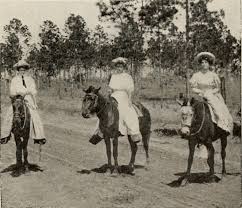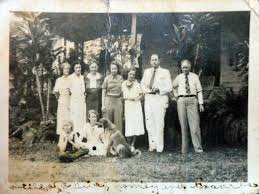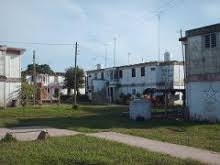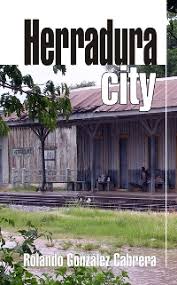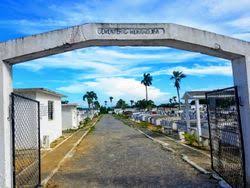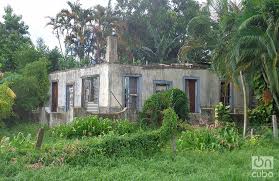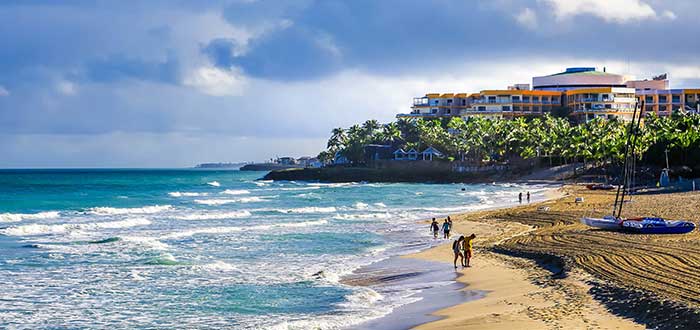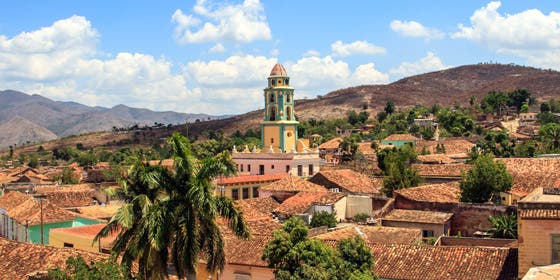THE CAMPAIGN IN THE U.S. TO FILL CUBA WITH NORTH AMERICAN COLONIES. “HERRADURA CITY”, PINAR DEL RIO. PHOTOS.
At the end of 1899 the North American company ‘Cuban Land and Steamship Company’ sent to the territory of Camagüey a team of surveying engineers headed by the engineer J.C. Kelly, those who were parceling out large territories for months from the Sierra de Cubitas to the sea, and limited by the Máximo river, that of the famous “buckets”, a natural accident made up of limestone rocks that cover about 350 meters along the river, which turn it into natural pools, used as spas, and whose extension they called “Valley of Cubitas” and began the foundation of one of the first North American colonies in Cuba, “La Gloria Colony”.
Starting from a campaign in the United States to stimulate the colonization of vast extensions of Cuban lands that, due to its fertility, made it a coveted prey, the ‘Cuban Land’ pursued the objective of filling the island with colonies of North American citizens. In Cuba, the project began almost simultaneously in thirty-seven locations, among them were the ‘Gloria City’ and a series of towns in the Cubitas Valley, such as’ Garden City ‘,’ City of Piloto ‘,’ Columbia City ‘,’ Washington City ‘,’ New Port ‘, and’ Port Viaro ‘, the latter a swampy beach full of mangroves. In this group were other projects such as those of Ceballos, Ciego de Ávila, Barthe, Omaja in Las Tunas and those already mentioned in Isla de Pinos and a curious one in Pinar del Río.
“HERRADURA CITY” A NORTH AMERICAN TOWN IN PINAR DEL RIO, CUBA
The ambitious plans of colonization of the island by North American companies gave rise to entire towns such as the Ceballos, Ciego de Avila, Barthe, Omaja in Las Tunas, Isla de Pinos, and those of Camagüey, but also in Pinar del Río. There the so-called Herradura City arose.
The company that had this initiative was called “The Herradura Land Company of Cuba” and began its operations in the territory that today occupies the municipality of Consolación del Sur, at the end of 1904 and only one year later, in December 1905, was would found the colony of Herradura City.
The main productions were the cultivation of citrus fruits, especially oranges, destined for the United States. These settlers were among the first to introduce in Cuba the use of chemical fertilizers to improve the yield of the land, for which they were also pioneers in a scientific analysis of soils. These studies covered the soils of Herradura and part of those of San Diego de Los Baños and notably benefited agriculture in these places.
Apart from being excellent producers, they were precious in the presentation of their merchandise, to the point that they transported their products in air-conditioned wagons so that they would not lose freshness during the journey to the North American markets.
They maintained their lifestyle by making women, as in the typical farms of the United States, were in charge of feeding the chickens, pigs, and other animals and diversified their productions with the production of cheese, butter, wines that were sold and they were very well accepted in Cuba and in the United States.
The history of some of its first settlers is known, when in the first decade of the 20th century, Leon Charles Scott and Rosa Holton Scott arrived in Pinar del Río because of the benefits of the climate and in search of a new beginning. With them came their children Harold, Vivian, Leona, and little Theodore. Coming from North Dakota, they sold the store they owned to embark on this adventure. Leon Scott created the ‘Montevista’ farm, with its extensive orange groves and he lived part of the 1920s in the United States where he attended high school, in addition to the University in Virginia, where he graduated as an engineer.
Before there had been other similar colonization efforts on the Island and all the settlers began by founding a city in the most rancid American style and bringing with them their most deeply rooted customs. And in all cases, knowing that prosperity came with them, people of many nationalities also came, in this case, Germans, Canadians, English, and Chinese. The cemetery was built in 1906 and was initially for Americans only.
THE NORTH AMERICANS SET UP ON THE ISLAND
The Northerners bought plots that, with time and work, became prosperous farms that produced fruit and citrus trees, aubergines, beets, peppers, tomatoes, carrots, pasture for cattle, and vertical silos for hay. Until the 1920s, the products of the area were in high demand in the United States and the railroad was the center of the movement of goods, which later went by ship to the northern country.
The constructions were made in the northern style like the ‘Royal Palm Hotel’ and the chalet ‘American Society’, centers of social life and festivities, such as those of the 4th of July, and the habits of the country included that in a short time the arrival of the electricity and Ford cars.
But the decline began when several families left and many of the lands were not very fertile for fruit trees and salinization was increasing. US laws and producers in North American territory began to dominate the sale of fruit, which, added to the bank crash and the 1929 crisis, gave Herradura City the coup de grace.
By the 1940s, the losers had left Herradura, only the winners such as Mr. Gerse and those who, like Theodore Scott, had embraced the pleasant atmosphere of that place, which he arrived at when he was still very young, remained. Theodore spent his final days at Rosa’s house, listening to North American stations and reading the magazines brought by his sister Vivian on visits to Cuba.
But despite the failure of Herradura City, the ‘Montevista’ ranch maintained its vitality and good dividends. The Northerner bought the productions of others, sold them first, and then, with the scarcity, he gave out his own. With a truck, he distributed the oranges in the hospitals and other centers of Pinar del Río.
There are scant traces of what was once a prosperous colony in Cuba, but some historians say that the lands possess a type of historical heritage. Today’s town has the reputation of being a “money town”, of enterprising and hard-working people, a possible inheritance, of the American sap that merged with the locals and other immigrants, and that keeps the essence of the disappeared colony alive.
And as it happens in all of Cuba, the inhabitants of this place and of all the North American colonies that existed in Cuba, now emigrate seeking fortune and especially freedom on American soil, from where the settlers came back in the early years of the 20th century. .
Now the itineraries are reversed, the destinations are sought in reverse, but in the history of Cuba, there will always remain the influence that the North American colonies brought us in our country, similar to the footprint that the Cubans have left on our neighbor to the north. , particularly in the state of Florida and especially in the city of Miami, showing that despite the distance and time, we are not so different.
LA CAMPAÑA EN EEUU DE LLENAR A CUBA DE COLONIAS NORTEAMERICANAS. “HERRADURA CITY”, PINAR DEL RIO
A finales de 1899 la compañia norteamericana ‘Cuban Land and Steamship Company’ envió hacia el territorio de Camagüey a un equipo de ingenieros agrimensores encabezado por el ingeniero J.C. Kelly, los que estuvieron parcelando durante meses grandes territorios desde la Sierra de Cubitas hasta el mar, y limitados por el río Máximo, el de los famosos “cangilones”, accidente natural conformado por rocas calizas que cubren unos 350 metros a lo largo del río, que lo convierten en piscinas naturales, utilizadas como balnearios, y a cuya extensión llamaron “Valley of Cubitas” y comenzaron la fundación de una de las primeras colonias norteamericanas en Cuba, “La Gloria Colony”.
A partir de una campaña en los Estados Unidos para estimular la colonización de vastas extensiones de tierras cubanas que, por su fertilidad la hacían presa codiciada, la ‘Cuban Land’ perseguía el objetivo de llenar la isla con colonias de ciudadanos norteamericanos. En Cuba el proyecto comenzó casi simultáneamente en treinta y siete localidades entre ellas estaban la ‘Gloria City’ y una serie de poblados del Valle de Cubitas, tales como ‘Garden City’, ‘City of Piloto’, ‘Columbia City’, ‘Washington City’, ‘New Port’, y ‘Port Viaro’, esta última una playa pantanosa llena de manglares. En este grupo estaban otros proyectos como los de Ceballos, Ciego de Ávila, Barthe, Omaja en Las Tunas y las ya citadas en Isla de Pinos y una curiosa en Pinar del Río.
“HERRADURA CITY” UN PUEBLO NORTEAMERICANO EN PINAR DEL RIO, CUBA
Los ambiciosos planes de colonización de la Isla por parte de compañías norteamericanas hicieron surgir pueblos enteros como los Ceballos, Ciego de Avila, Barthe, Omaja en las Tunas, en Isla de Pinos y los de Camagüey, pero también en Pinar del Río. Allí surgió el llamado Herradura City.
La empresa que tuvo esta iniciativa se llamó “The Herradura Land Company of Cuba” y comenzó sus operaciones en el territorio que hoy ocupa el municipio de Consolación del Sur, a finales del año 1904 y solamente un año después, en diciembre de 1905, se fundaría la colonia de Herradura City.
Las producciones fundamentales fueron el cultivo de los cítricos, sobre todo naranjas, con destino a Estados Unidos. Estos colonos fueron de los primeros que introdujeron en Cuba el uso de los abonos químicos para mejorar el rendimiento de las tierras, para lo que también fueron pioneros en un análisis científico de los suelos. Estos estudios abarcaron los suelos de Herradura y parte de los de San Diego de los Baños y beneficiaron notablemente a la agricultura en estos lugares.
Aparte de ser excelentes productores, fueron preciosistas en la presentación de sus mercancías, al punto de que trasladaban sus productos en vagones climatizados para que no perdieran frescor durante la travesía hacia los mercados norteamericanos.
Mantuvieron sus hábitos de vida haciendo que las mujeres, como en las típicas granjas de los Estados Unidos, fueran las encargadas de alimentar las gallinas, los cerdos y demás animales y diversificaron sus producciones con la elaboración de queso, mantequilla, vinos que se vendían y tenían muy buena aceptación en Cuba y en Estados Unidos.
Es conocida la historia de algunos de sus primeros pobladores, cuando en la primera década del siglo XX, Leon Charles Scott y Rosa Holton Scott llegaron a Pinar del Río por las bondades del clima y en busca de un nuevo comienzo. Con ellos venían sus hijos Harold, Vivian, Leona y el pequeño Theodore. Procedentes de Dakota del Norte vendieron la tienda que poseían para embarcarse en esta aventura. Leon Scott creó la finca ‘Montevista’, con sus extensos naranjales y vivió parte de la década del 20 en Estados Unidos donde cursó la enseñanza media, además de la Universidad en Virginia, donde se graduó de ingeniero.
Ya antes se habían producido otros empeños similares de colonización en la Isla y en todos los colonos comenzaban fundando una ciudad al más rancio estilo estadounidense y traer con ellos sus más arraigadas costumbres. Y en todos los casos, sabiendo que con ellos venía la prosperidad, vinieron también personas de muchas nacionalidades, en el caso que nos ocupa, alemanes, canadienses, ingleses y chinos. El cementerio fue construido en 1906 e inicialmente era solamente para norteamericanos.
LOS NORTEAMERICANOS SE ASIENTAN EN LA ISLA
Los norteños compraron parcelas que, con tiempo y trabajo, se convirtieron en fincas prósperas que producían frutales y cítricos, berenjenas, remolachas, pimientos, tomates, zanahorias, pastos para el ganado vacuno y silos verticales para el heno. Hasta la década de 1920, los productos de la zona eran muy demandados en Estados Unidos y el ferrocarril era el centro del trasiego de mercancías, la que después iba por barco a al país del norte.
Las construcciones se hicieron al estilo norteño como el ‘Royal Palm Hotel’ y el chalet ‘American Society’, centros de la vida social y las festividades, como las del 4 de Julio, y los hábitos del país incluyeron que en poco tiempo llegara la electricidad y los autos Ford.
Pero comenzó el declive cuando varias familias se marcharon y muchas de las tierras no eran muy fértiles para los frutales y la salinización iba en aumento. Las leyes estadounidenses y los productores en territorio norteamericano comenzaron a dominar la venta de frutas, lo que sumado al crack bancario y la crisis de 1929 le dio el golpe de gracia a Herradura City.
Para los años 40 los perdedores se habían marchado de Herradura, solo quedaban los triunfadores como Mr.Gerse y aquellos que como Theodore Scott se habían acogido al agradable ambiente de aquel lugar, al que llegó siendo aún muy pequeño. Theodore vivió sus días finales en casa de Rosa, escuchando emisoras norteamericanas y leyendo las revistas traídas por su hermana Vivian en las visitas a Cuba.
Pero a pesar del fracaso de Herradura City, la hacienda ‘Montevista’ mantuvo su vitalidad y buenos dividendos. El norteño compraba las producciones de los demás, las vendía primero, y después, con la escasez, daba salida a las suyas. Con un camión distribuía las naranjas en los hospitales y otros centros de Pinar del Río.
Hay escasos rastros de lo que fuera una próspera colonia en Cuba, pero algunos historiadores dicen que las tierras son poseedoras de un tipo de herencia histórica. El pueblo actual posee la fama de ser un “pueblo de dinero”, de gente emprendedora y trabajadora, una herencia posible, de la savia estadounidense que se fundió con los lugareños y otros emigrantes, y que mantiene viva la esencia de la desaparecida colonia.
Y como ocurre en toda Cuba, los habitantes de este lugar y de todas las colonias norteamericanas que existieron en Cuba, emigran ahora buscando la fortuna y sobre todo la libertad en suelo americano, de donde vinieron los colonos allá por los primeros años del siglo XX.
Ahora los itinerarios están invertidos, los destinos se buscan a la inversa, pero en la historia de Cuba siempre va a quedar la influencia que nos trajeron las colonias norteamericanas en nuestro país, parecidas a la huella que han dejado los cubanos en el vecino del norte, en particular en el estado de la Florida y sobre todo en la ciudad de Miami, demostrando que pese a la distancia y el tiempo, no somos tan diferentes.
Agencies/ MemoriasCubanas/ Carlos RodriguezB. / Extractos/ Excerpts/ Internet Photos/ Arnoldo Varona/ www.TheCubanHistory.com
THE CUBAN HISTORY, HOLLYWOOD.





